

Contemporary Community; the Existence of the Communal in Individualist Society
 By: Alexandra Gordon
By: Alexandra Gordon
In recent years questions concerning the state of community in modern society are insistently recurring. Polarizing politics, an increasing wealth gap, rising social tensions, and feeling of loss of civic discourse as we once understood it all threaten ideas of the possibility for strong, diverse community to exist in the modern world. Recently, the COVID-19 virus has challenged former conceptions of community by inhibiting the ability to convene in shared spaces, caused a severe spike in unemployment removing people from their usual network of social and productive interactions, forced many of those who remained employed to transfer to online space in which all social interactions takes place via scheduled video meetings with no room for unintentional or organic interactions, and canceled countless conferences, community meetings and other means of traditional community building. These struggles only pile onto the preexisting threats to community and identity posed by modern day capitalism including exploitation of the individual for labor, increased privatization, alienation of language and communication, rigidity and homogeneity that negates opportunity for the perception of phenomena, and encourages the mass production of space that reduces its users to exist as relatively nothing more than a customer, passenger, user etc. Despite all these truths, or perhaps directly because of them, desire for the makings of community in the physical environment, the workplace, the home and in the construction of social, spiritual, political and economic organization is stronger than ever. This is evident in movements, projects, proposals and initiatives taking place across the globe.
To effectively examine, consider, or critique these examples however one must first develop a definitive understanding of the meaning of community. There are many interpretations which focus on different aspects of community theory from language, to human nature, to adaptability, to identity as well as societal or larger scale ideas of politics, power, autonomy, privatization and collective agency. French philosopher Jean Luc Nancy understands community not as an
assemblance of individuals nor an absolute total, but instead finds it in the inclination of one towards or from the other. He refers to community not as grouping of people but as this very relation between individual and total. In his work, The Inoperative Community, he writes, “The relation (the community) is, if it is, nothing other than what undoes, in its very principle-and at its closure or on its limit-the autarchy of absolute immanence.”⁴
Without the other or the multitude, there is no individual in that identity is lost since it exists only in relation or comparison between different individuals. Similarly, without the individual, community cannot exist as communication, interaction, cooperation, discourse and intentional collective action cannot take place without individuals to create the necessary connections needed to carry out these relational acts. It is in this way that community exists as a relationship and it also in this way that one can understand where failures could possibly take place leaving a lack of community in the absence of a functioning relationship between the singular and the total. A clear example of this relationship and the implication for both entities involved is given in Antonio Negri and Michael Hardt’s Multitude: War and Democracy in the Age of Empire. “Queer politics is an excellent example of such a performative collective project of rebellion and creation. It is not really an affirmation of
homosexual identities but a subversion of the logics of identity in general. There are no queer bodies, only queer flesh that resides in the communication and collaboration of social conduct.”⁵ (image 1) Using the example of queer politics, Negri and Hardt undermine the logics of identity by understanding the concept similarly to Nancy, that is as defined by a relationship or in this case as a communication. The negation of the existence of queer bodies and instead proposal of the concept of “queer flesh” again reveals an existence of identity as only possible relationally to other entities. The queer community can only be understood as a community in that it exists in the commonality of sexual or gender identities of individuals as countering (relational) the norm. This reinforces the concept of identity as determined by relationship, introduces the idea of identity as a social construct, and raises questions about the nature of identity being a means of defining community instead of say place or affiliation. In the instance of the queer community for example, one could potentially identify with one of the sexual or gender identities under the umbrella term of queer without having to observe or partake in any more discourse than that required to understand their own affiliation. This could be very minimal. This example brings into question the idea of a means of measuring different strengths of community. No matter the strength, size, or type (identity, place, affinity, etc.) of community however, it is clear that when discussing theories of community it must be understood as relational.
This relationship can be used to better understand the threats to community presented by different aspects of modern life by setting a framework for questioning whether the threat is to the individual (identity), the multitude (or common), or directly the relationship of the two. Capitalism and supermodernity are widely criticized for undermining community, and they do so at both the level of the individual as well as the multitude. French anthropologist Marc Auge famously criticizes capitalism for its production of what he calls “nonplaces”. (image 2) He understands nonplace to be the antithesis to place or anthropological space which he defines as “… relational, historical and concerned with identity...”². Nonplace therefore exists in the absence of these factors and is found mostly in spaces of commerce and transit. Auge argues that in these spaces, objects and images are the main forms of communication and they are used only to satisfy immediate desire (no history). Image culture, as perpetuated by capitalism, encourages a society of spectacle in which individuals observe but do not converse, experience, or question (no anthropological relationship). These spaces are reductive as they only allow for relationships of individuals as pieces of whatever profitable system they are moving through. “…supermodernity is inhabited by this contradiction: it deals only with individuals (customers, passengers, users, listeners)”². In this way the identity of the individual is compromised for commerce. Italian philosopher Giorgio Agamben also criticizes capitalism for its hindrance of language and communication, seemingly viewing it as one of the largest threats against the possibility for community. “...capitalism (or any other name one wants to give the process that today dominates world history) was directed not only toward the expropriation of productive activity, but also and principally toward the alienation of language itself, of the very linguistic and communicative nature of humans.”¹ To look at this concept under the lens of the relationship between the individual and the collective, individual identity is lost as the relation between different individuals dissipates in space
 2.
2.
meant only to inhabit individuals as customers, clients, passengers, etc., so by extension the ability form meaningful relationships, interactions or communication is lost breaking the relationship needed to constitute community. Beyond the increase in commercial and transit spaces, capitalism generally encourages the privatization of space. Economically, capitalism supports that to maximize productivity of space, everything should be made private and subject to property rights. Interestingly however there simultaneously exists a contemporary attack on the “privacy of the private” in the name of security and antiterrorism. The degree to which the government has access into nearly every privately owned space through access to communications including text messages, emails and satellite calls has rendered essentially no real private space in the understanding of it as a space separate or free from the state. Public space on the other hand by the nature of being ultimately owned by the governing body has always been an open playing ground for surveillance. “Security is an absolute logic of the common or, really, a perversion that conceives the entire common as the object of control.”⁵ Under modern capitalism, private property is no longer private and public space is not controlled by the common. This brings into question the limitations on interaction and discourse created by the control over these spaces by the state. Discourse surrounding topics of large impact to place-based, urban or residential communities that reveal divergence occurring from state laws, such as around topics of drug use for example, could be hindered under the threat of surveillance. With proper communication being the basis for collective action, this disregard of the privacy of the common possibly negates opportunity for change to occur within a community that truly reflects aspirations of the multitude. It is found in numerous examples that, “The unintended outcomes of [these] blind interactions between interdependent actors are often disadvantageous for all or most people…”³. These adverse outcomes are made far more likely when space for the common does not allow for meaningful civic discourse and interaction. Another
downfall of space for the common being owned by the state is the limitations it creates on the surrounding community’s ability to change or adapt the space for needs or strengths of the individuals. When laws prevent adaptation or reclamation of common space for community needs, specifically when the demands for these changes arise from collective intentionality, then common space is no longer for the common.
Threats against the existence of the common and the identity of the individual are not going by unnoticed. A great number of projects exist that fight back against these threats in a variety of different approaches, all while simultaneously revealing a contemporary yearning for community in modern society. An example of one such project is the intentional community of Christiania in Copenhagen which continues to function 50 years after its establishment in 1971. Denmark’s relatively tolerant government has allowed the community to exist (perhaps because it attracts a large number of tourists and therefore has a positive effect on the economy) despite a number of its governing principles breaking national zoning and drug laws. The rules established in Christiania are a result of lengthy debates and discussions among the majority of its population, making each ruling the product of collective intentionality. The identity of the individual is kept alive in the creation of a common space that allows for interaction and communication truly made for the common as the rules that dictate it and the way in which it is designed or maintained is the result of collective intentionality. Where the relational organization cuts short however is
 3.
3.
between Christania and the Danish government. If a citizen of Christania exists as an individual making up the multitude that is the intentional community, then Christania exists as a multitude within the multitude that is Denmark. At this scale a multitude of multitudes needs to be considered and its success or failure is determined similarly to the way in which the small scale relationship operates; on the possibility for communication and discourse. The unwillingness on both sides, Christania and the Danish government, to communicate and reach consensus on disagreements threatens the intentional community project. A strong relationship between the common and individual entities can take different forms than an initial community. In Berlin efforts by the public to maintain Tempelhofer Feld, a reclaimed army airport turned communal greenspace, reveals a strong desire for adaptable communal space in proximity to the urban city. (image 3) Tempelhofer Feld is a realized example of the aspirations of Negri and Hardt, specifically their claim that “All that is general or public must be reappropriated and managed by the multitude and thus become common.”⁵ By this definition Tempelhofer Feld is truly common and attempts by developers to profit from this valuable land have failed due to the efforts of the local community. Another type of this relationship can be found in co-living or co-housing has also increased in popularity as a more affordable living option, which is especially favorable as fear of unemployment and the wealth gap remain high. Co-housing is also a remedy to urban loneliness and isolation brought about by the threats to identity caused by capitalist society, while still offering the convenience and ergonomic benefits of urban life. Commonplace in these coliving projects is a high regard for sustainability and strong sense of environmental responsibility. While capitalism causes many threats to the possibility of community, it also causes destruction of the environment which these built communities are attempting to counteract. Interestingly, projects like the Mondragon Corporation reconsider the idea of privatization and challenge the stereotype that co-
ops can only be maintained as small scale, limited enterprises. By distributing ownership among partners, Mondragon creates space organized by its occupants through their work and involvement, but just as importantly it fosters opportunity for communication, cooperation and interaction of individuals in common space.
These examples are all indicative of a call for change along some variation of that put forth by Negri and Hardt. “We need to begin to imagine an alternative legal strategy and framework: a conception of privacy that expresses the singularity of social subjectivities (not private property) and a conception of the public based on the common (not state control)-one might say a postliberal and postsocialist legal theory”⁵ By understanding the dependent relational nature of community, the threats posed to it by modern organization of economic and social society, and finally by examining the aspirations and shortcomings of modern community projects, then and only then are designers and visionaries truly able to design for community in a predominantly capitalist world.
Citation
1. Agamben, Giorgio 1942-, and Michael Hardt. The Coming Community. University of Minnesota Press, 1993.
2. Auge, Marc. Non-Places: An Introduction to Supermodernity. London, NY: Verso, 2009.
3. Bouvier, Alban. “Individualism, Collective Agency and the ‘Micro–Macro Relation.’” The SAGE Handbook of the Philosophy of Social Sciences, 2014, 199–216.
4. Nancy, Jean-Luc, and Peter Connor. The Inoperative Community. University of Minnesota Press, 2012.
5. Negri , Antonio, and Michael Hardt. Multitude: War and Democracy in the Age of Empire. New York: The Penguin Press, 2009.
6. Virno, Paolo. “Natural-Historical Diagrams: The ‘New Global’ Movement and the Biological Invariant.” Cosmos and History : the Journal of Natural and Social Philosophy, Cosmos and History Publishing Co-op, Vol. 5, no. 1, 2009, 92–104
Establishment, Identity and Adapting to Capitalism [Kibbutz, Israel]
Kibbutz, which translates to mean “gathering”, is a type of intentional community that first appeared as agricultural settlements established by young Jews in the former half 1900s who bought land in Israel by the Jewish National Fund. After the events of World War II, these collectives provided the building blocks for a new kind of Jewish identity, that of the self-sustained and hardworking Israelis distinct from the diaspora Jews, scattered and broken by the horrors of the holocaust. Today there are roughly 270 Kibbutzim across Israel, which continue to survive in large part because of the ways they have adapted from a once socialist society to now one of free-market capitalism. When agriculture was no longer a sustainable export due to the effects of globalization, members started to find work outside of the kibbutz. This was possible due to many Kibbutzim undergoing a privatization process that made it so members who worked outside the community were expected to pay private taxes for community upkeep. Privatization also made it so members could buy land on the kibbutz. Despite these changes, Kibbutzim remained communal by providing benefits for members, hosting community activities, and providing allowances for members who lost their jobs while they searched for new work. Today, Kibbutzim are seeing a rise in membership with an increasingly younger population being drawn in by the affordable housing and sense of community lost in the impersonal cities.
“What Is a Kibbutz?” Tourist Israel, May 3, 2021. https://www.touristisrael.com/what-is-akibbutz/6053/.
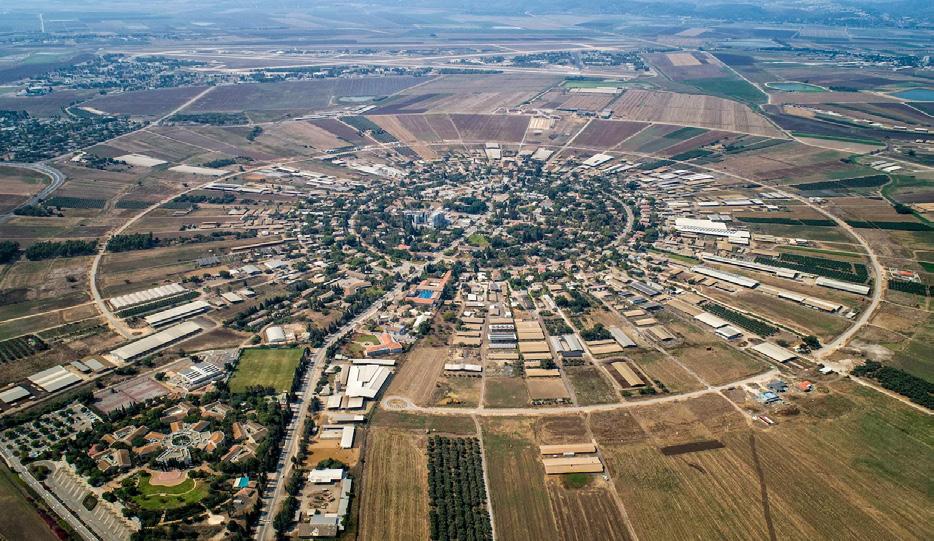

Art, Craft, Reclamation and Conflicting Laws [Freetown Christiania, Denmark]
Existing on the grounds of a retired military squatting zone, Freetown Christiania’s roots are in a population of homeless individuals who reclaimed the space as a protest against the lack of affordable housing provided by the Danish government. Today, Christiania is recognized as a commune of self-proclaimed artists and freethinkers. It stands as one of Copenhagen’s biggest tourist attractions and the art and handmade goods produced, famously cargo bikes of their own invention, are sold across Europe. To earn their place in Christiania, most residents commit their time to one or multiple of the many small businesses that underpin the commune. The community operates as a “selfgoverning society” with its strict set of rules set outside of any form of interaction with the Danish government. These rules forbid violence, knives, guns, hard drugs, stealing, and bulletproof vests. Failure to follow these rules results in banishment from the community, something that can only really work at the relatively small scale that Christiania operates on. Out of these rules, the one that draws the most attention from the surrounding city is the ruling on drug use which permits marijuana sale and use on the commune despite it being an illegal substance in the country of Denmark. For many years, the Danish government has tolerated these law violations but several recent incidents between police and community members have raised tensions. This raised distrust on behalf of both parties, Christianites and Police, has changed the occupation of the commune’s market to a constant game of cat and mouse. Mobility is key for hash dealers as when an officer approaches, they must quickly hide their product until the threat passes and they can resume business as usual.
Barry, Ellen. “In Anarchic Corner of Copenhagen, Police and Dealers Play Cat and Mouse.” The New York Times. The New York Times, August 26.




Cooperation, Security, Scale and the Reality of Distribution
[Mondragon,
Spain]
Employing more than 70,000 citizens in Spain, the Mondragon Corporation defies the stereotypes that co-ops can only maintain small-scale, limited enterprises. The organization first began as a small university now known as Mondragon University, which was initiated by a priest by the name of Jose Arizmendiarrieta to provide educational opportunities to the poorly paid and poorly treated industry workers of the Basque Country. From this university, Arizmendiarrieta convinced five of his first graduate students to pitch into starting a cooperative engineering company that would produce heaters. This was only the first of many cooperatives that would soon take over the town of Mondragon’s economy. Today, Mondragon functions as a worker cooperative federation with a number of different autonomous businesses operating under it. The variety and number of different businesses allow for numerous different opportunities throughout the system as well as a form of job security being the offering of a completely different position should a partner lose their job at one of the cooperatives. This allows for adaptability and gives security as well as certain opportunities for engagement in varied work communities for the individual. This model creates protection against bankruptcy and unemployment in its spread of wealth and resources. This sense of security allows for a work environment based on teamwork and community as competition is driven by the desire to move up in the company rather than by the fear of total loss of income. One pitfall of course is that to always ensure a paycheck for all partners when one branch of the system struggles all the others are subject to it, even if it isn’t to a substantial degree.
Goodman,
Peter S. “Co-Ops in Spain’s Basque Region Soften Capitalism’s Rough Edges.” The New York Times. The New York Times, December 29, 2020.Meditation, Inner Balance, Architectural Manifestation, and Societal Isolation
[Maharishi Vedic City, Iowa]
Established in 2001, Maharishi Vedic City is a transcendental meditation-themed town located in rural Iowa. The ideals of the town are based around the Hindu principles of Veda, meaning “knowledge”. These principles include promoting balance, harmony, and natural law. These principles are clearly manifested in the plan layout, as well as the architectural details and orientation of buildings on-site, all of which align towards the sun’s movement. Made possible by the vision of San Francisco real estate developer Chris Johnson, Vedic City is organized on a ring of ten circles that span just over one square mile. The town is equipped with its own observatory to observe and orient oneself within the cosmos. Outside of the observatory and meditation space, however, most of the other spaces are that of recreation with the exception of the greenhouses. The greenhouses represent an underlying desire for autonomy and self-sufficiency and also appear to be the one concrete relation the micro town seems to share with the outside community by means of their selling their produce. Despite their isolation, town members claim a connection to the larger world by the means of transcendental meditation, which of course, can never be proven in any tangible way.
Blank, Lew. “An Unlikely Transcendental Meditation Haven in the American Heartland.” Atlas Obscura. Atlas Obscura, February 1, 2017.
Lee, Jennifer. “In Many Ways, a New Iowa Town Looks to East.” The New York Times. The New York Times, April 17, 2001.




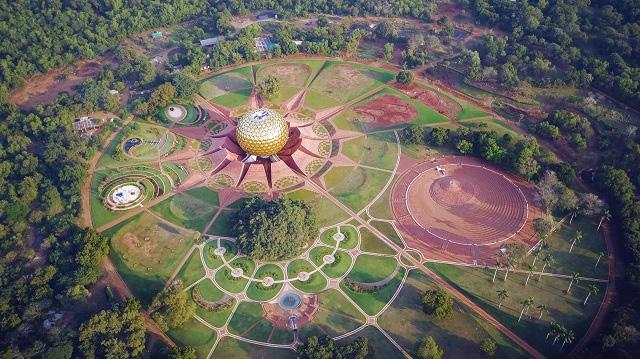
Spirituality, Diversity, Urbanization and Questionable Economics [Auroville, India]
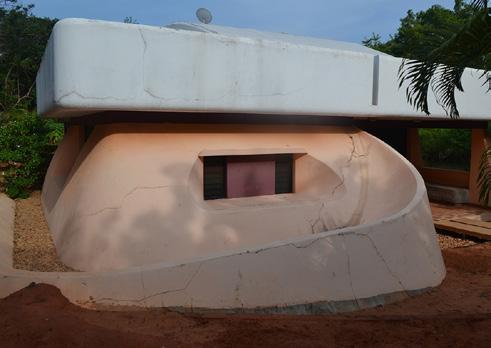
First recognized in 1968, Auroville was the realized dream of Mirra Alfassa, a spiritual leader and dual citizen of France and India. She envisioned Auroville as an idyllic township where commerce and material enjoyment would no longer preside over the needs of the spirit. In this town where man is no longer expected to earn money to justify his survival, individualistic worth would become far more important as it would no longer be material worth or social standing that determines worth but one’s willingness or ability to build relationships and share individual talent and ability with one’s community. The master plan for Auroville was in part a response to the rapid urbanization taking place in India at the time, which was taking a toll on natural resources, causing food insecurity, and leaving more and more citizens in low-quality housing. Auroville’s proposed solution was a more spread development with mixed population densities making it so that sectors of food production, water management, waste management, and other necessary amenities to sustain healthy living were geographically accessible to both rural and urban citizens. This fluctuation or diversity of population density also reflects the township’s general value for diversity, it’s embracing of the unique. Where the vision seems to have fallen short today however is in its economic and anti-privatization aspirations. Mandatory donations are required for Aurovilians to become “stewards” of their homes, yet the same homes often appear in architecture or retail magazines listed as for sale. Auroville does not have a self-sustaining economy so many Aurovilians leave for many months of the year to earn money to pay for mandatory donations. These payments on top of money donated by the Indian government adds up to a surprisingly high amount, especially for a township in which its citizens are not supposed to have currency.
“Welcome to Auroville.” Auroville. Accessed May 19, 2021. https://auroville.org/. Crowell, Maddy. “A Spiritual Utopia Struggles With Crime and Corruption.” Slate Magazine, July 24, 2015.
Autonomy, Interactive Design, Openness and Framed Adaptability
[Small Multiples | Un Bel Composto, Unbuilt Urban Project Proposal]
Victoria Hatsenko and Sahar Simforoosh, recent architecture graduates from the University of Illinois at Chicago, designed Small Multiples | Un Bel Composto in response to a prompt to design, “a community garden on a site surrounded by simple buildings.” Their approach to this rather simple prompt was to design a space that would involve the community through its openness, adaptability, and quality to be engaged and adjusted by the community. Who would know better what a communal space needs, Hatsenko and Simforoosh argue, than those who experience living and interacting in its intended community daily? The adaptable design proposed seeks to re-establish a connection between the community and the architecture around them. The site proposed in the given prompt existed within a predominantly industrial community and Hatsenko and Simforoosh quickly found that the social and collective needs of residents were often overlooked and that lack of possible engagement in the built and social environment made it difficult for community members to change the situation. The looseness and adaptability of the space proposed to answer these constraints manifest in the plan and program organization of the design. Strict bounding boxes and program are replaced by interpretable framing and inflatable systems that enables space for, “food forests, pollinator gardens, farms, animal farms, entertainment spots, and furthermore are ought to adapt accordingly to any program”. This interpretable landscape allows for autonomy and imagines that the allowance for grassroots design will result in unique forms, euphonic in that they reflect the realized workings and desires of the community.
“Small Multiples (Miniature Plots): Un Bel Composto.” KooZA/rch, May 17, 2021.



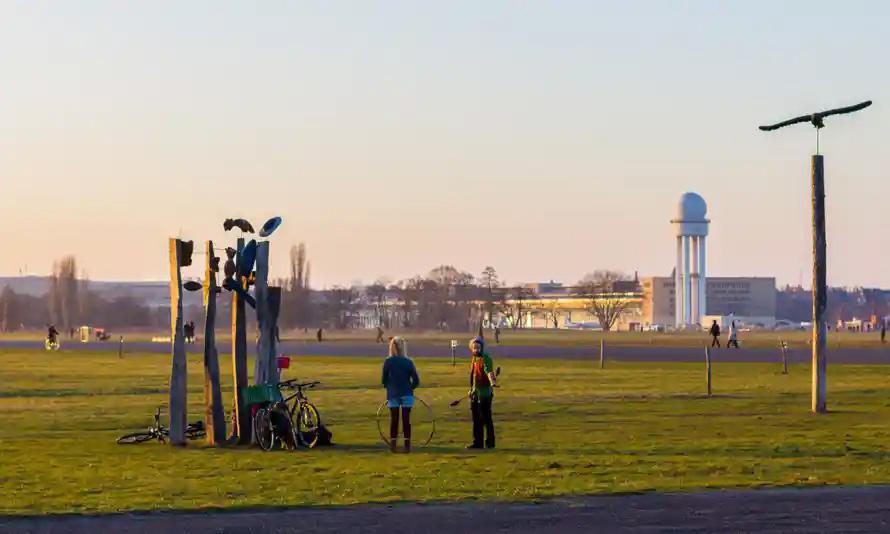
Reclamation, Debate, Urban Planning and Distrust in the Designer
[Tempelhofer Feld, Germany]
When the city of Berlin turned over the grounds of the former airport of Tempelhof to the public in 2010, it was likely underestimated to what degree the citizens would come to cherish it. The true value of the land came in its vastness, allowing for kite flying, rollerblading, urban gardens, picnics, barbeque, yoga classes, festivals, exhibitions, and more, all while in a prime location. It was a communal paradise in the urban landscape. Because of its value, however, developers were eager to reclaim at least a portion of the space for commercial space and apartments. Despite promises that only 25% of the site would be developed and that affordable housing would be included in the apartment complexes, the populace was still doubtful that the motives of the planners and developers were really in the citizens’ best interests. This struggle over who had the rights to the land however provided more opportunity for community interaction through the means of debates that spanned over several months. In the end, the collective intentionality of the local community resulted in a winning vote to keep Tempelhof exactly as is. This struggle for the protection of undeveloped, communal land reflects a modern desire for community, in this case, in the urban landscape. A distrust in city planners is also exposed with communal debate revealing a misalignment in the desires of the designer and the citizen.
“How Berliners Refused to Give Tempelhof Airport over to Developers.” The Guardian. Guardian News and Media, March 5, 2015.
Site Response, Movement, New Urban and the Risks of Idolizing the ‘Master Designer’
[Acrosanti, Arizona]
In 1970, construction began on the design of the late Italian architect Paolo Soleri for Arcosanti, a reimagined city with no roads, environmentally responsive buildings, and a plan layout designed for maximized efficiency. The lack of roads mixed with program density makes walking the main mode of transportation in this idyllic project. Walking rather than driving allows spaces of transit to become spaces of interaction and communication between citizens. The built architecture that lines these walkways displays curved asymmetrical forms that align with the movement of the sun so that the interior spaces are passively shaded in the summer and lit in the winter, lowering the need for artificial lighting, heating, and cooling systems and revealing respect for the capacities of nature on design that Soleri finds to be neglected by the modern urban landscape. Though many of the design aspirations reveal community and environmental interest that is continuously rising today, there are aspects of the proposed city that perhaps reveal why it is still only 5% complete. Notably, a cultural move away from the conception of the architect as the sole master designer would explain a modern disinterest in this highly designed, and relatively nonadaptable space. Also, it must be addressed that Soleri has been revealed to have sexually abused his own daughter putting into immediate question any ideas of morality aspired to in his work and even whether his work should be considered at all to influence design of the future.
Malloy, Chris. “Step Inside This City of the Future That Time Forgot.” Architectural Digest. Architectural Digest, January 11, 2019. “‘His Inner Circle Knew about the Abuse’: Daniela Soleri on Her Architect Father Paolo.” The Guardian. Guardian News and Media, February 29, 2020.
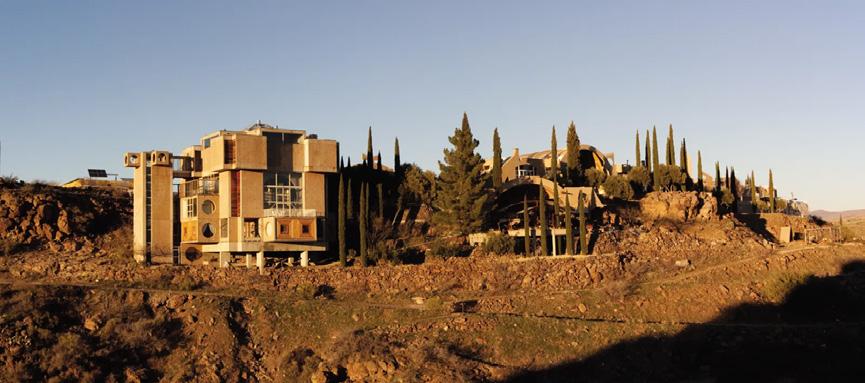


Self-Governance, Security, Support and the Limitation of Personal Progress [East Wind, Missouri]

East Wind, tucked away in the rural Ozarks of southern Missouri, is one of a growing number of modern-day intentional communities that have begun to gain traction across America. Sprawling over 1145 acres of primarily undeveloped forest, the site holds 27 building structures including dormitories, individual shelters, and communal productions spaces such as the kitchen facility, a nut butter manufacturing facility an automobile shop, and a number of farming structures. Communal distribution of nearly every aspect of life makes up the basis for East Wind’s social organization including, “meals, chores and living space to work, income, domestic responsibilities and the burden of self-governance.” This supposed burden of autonomous governing is actually cited as one of the reasons young people are increasingly seeking out this alternative style of life. Having a substantial say in how the society one lives in is organized and run is not presented in modern American society, and when faced with the products of its shortcomings (financial instability, food insecurity, unattainable housing) more and more individuals are turning to the benefits and security of intentional community life. Though many living at East wind have lived there for many decades and all members are not constrained by a limited time frame of stay, one might question if the lifestyle of an intentional community allows for the later reintroduction into modern society for its inhabitants. The share of resources provides everyone a bed to sleep in and food to eat, but there is no system for saving personal funds if one were to want to eventually leave the isolated community.
Barry, Ellen. “In Anarchic Corner of Copenhagen, Police and Dealers Play Cat and Mouse.” The New York Times. The New York Times, August 26, 2018.


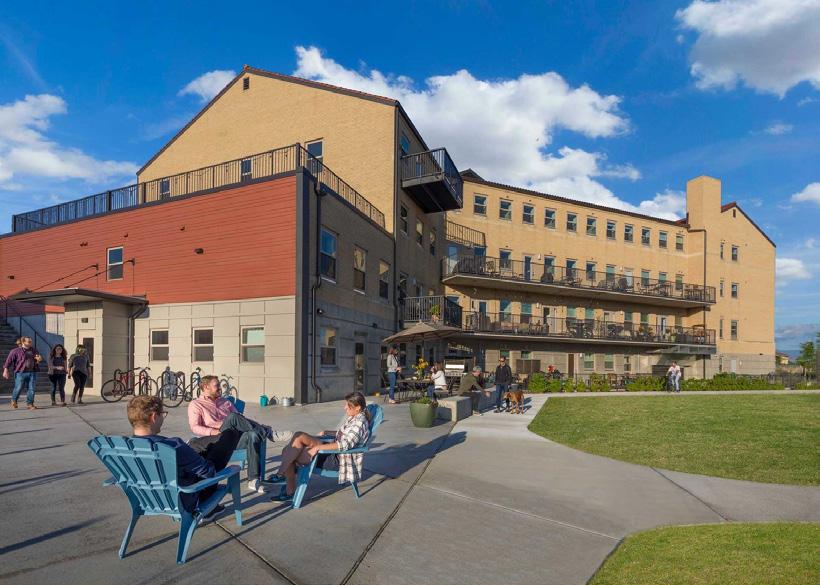

Proselytism, Knowledge and Assumptions for 21st Century Living [Aria Cohousing, Colorado]
Aria Cohousing is a modern urban living community that roots its ideals in the principles of the Sisters of St. Francis, the original owners of the Aria Denver property. In the 1950s the Sisters of St. Francis, a Franciscan congregational group of women who provide education and health service, commenced construction on a convent that was part dormitory part classroom, and part library. This convent eventually became Marycrest High School for Girls until 1986 when the organization began to extend its operations. The convent came to support child and adult day care, assisted living facilities, transitional housing for women in need, and offices for the residences and sisters. After a decline in residents, however, the Sisters of St. Francis eventually decided to have the existing buildings demolished and sold the land. Though the ownership switched hands, the new owners planned on honoring a number of the communal successes of the Sister’s convent in their plans for Aria Denver. One distinct difference was that Aria Denver would be without the basis of a single religious belief system and instead have more of an interest in environmental stewardship. The success of the project reveals a modern interest in this living style rooted in dormitory living. This concept invokes ideas of education (furthered by the site’s proximity to a local university), environmental responsibility (occupying a smaller space of living), and a hierarchy of importance of social interaction and community proximity over the attainment of the traditional American dream home.
“Cohousing.” Aria Denver. Accessed May 19, 2021. https://www.ariadenver.com/cohousing.
Image Citation
1. “About Face: Stonewall, Revolt and New Queer Art.” Wrightwood 659. Accessed May 19, 2021.
2. Leggett, Bianca et al. “Departures: The Novel, the Non-Place and the Airport.” 21st century writing, October 20, 2020.
3. Patowary, Kaushik. “Abandoned Tempelhof Airport Now Berlin’s Largest Park.” Amusing Planet. Blogger, October 19, 2020.
4.“What Is a Kibbutz?” Tourist Israel, May 3, 2021. https://www.touristisrael.com/what-is-akibbutz/6053/.
5. Rubin, Shira. “Live the Communal Life for a Night on an Israeli Kibbutz.” Lonely Planet. Lonely Planet, October 1, 2018.
6. Barry, Ellen. “In Anarchic Corner of Copenhagen, Police and Dealers Play Cat and Mouse.” The New York Times. The New York Times, August 26.
7. Goodman, Peter S. “Co-Ops in Spain’s Basque Region Soften Capitalism’s Rough Edges.” The New York Times. The New York Times, December 29, 2020.
8. Wren, Adam. “The Iowa Town Where Marianne Williamson Is Already President.” POLITICO. POLITICO, January 6, 2020.
9. Staff, Source, Sarah Kingsbury, and Jocelyn Engman. “Tour the Maharishi Vedic Observatory: Online Preview Tour Available.” Iowa Source, December 12, 2017.
10. “Flipbook.” Maharishi Vedic City. Accessed May 19, 2021. https://www.maharishivediccity-iowa.gov/ map-book/?page=6.
11. “Top 20 Tourist Places to Visit and Things to Do in Pondicherry.” TripNxt Blog, June 24, 2020.
12. Deutsche Welle. “India’s Auroville Shows the Way in Green Living: DW: 05.02.2013.” DW.COM. Accessed May 19, 2021.
13. Crowell, Maddy. “A Spiritual Utopia Struggles With Crime and Corruption.” Slate Magazine, July 24, 2015.
14. “Small Multiples (Miniature Plots): Un Bel Composto.” KooZA/rch, May 17, 2021.
15. “Tempelhofer Feld (Tempelhof Field).” visitBerlin.de. Accessed May 19, 2021.
16. “How Berliners Refused to Give Tempelhof Airport over to Developers.” The Guardian. Guardian News and Media, March 5, 2015.
17. Malloy, Chris. “Step Inside This City of the Future That Time Forgot.” Architectural Digest. Architectural Digest, January 11, 2019.
18. East Winds Blog. Accessed May 19, 2021. https:// www.eastwindblog.co/wp-content/uploads/2019/03/ East-Wind-Map-for-upload.jpg
19. Barry, Ellen. “In Anarchic Corner of Copenhagen, Police and Dealers Play Cat and Mouse.” The New York Times. The New York Times, August 26, 2018.
20. “Cohousing.” Aria Denver. Accessed May 19, 2021. https://www.ariadenver.com/cohousing.
